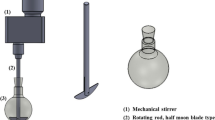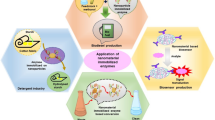Abstract
A method for the immobilization of lipoxygenase (LOX) in an alginate-silicate gel matrix was developed. In this method, a mixture of calcium alginate beads and LOX in borate buffer are dispersed into a hexane solution of tetramethoxy-ortho-silicate (TMOS). Hydrolysis of the TMOS gives products that permeate and co-polymerize with the alginate gel to form a colloid within the beads that entraps the LOX. Optimum reaction conditions for sol-gel entrapment of LOX are at pH 9.0 in 0.2M borate buffer. The composite gel, after isolation and vacuum drying, had excellent protein retention that has good enzyme activity and stability at room temperature. The activity of the entrapped LOX was less than the activity of the free enzyme. However, the activity of the immobilized LOX can be restored by the addition of borate buffer and glycerol, or borate buffer saturated with an organic solvent. In contrast to the free enzyme in solution, which loses its activity in less than one day, sol-gel entrapped LOX retains its activity at ambient temperature for at least 25 days and can be recycled. This report demonstrates that the sol-gel entrapment method for immobilizing LOX can be useful in developing a process for the oxidation of polyunsaturated fatty acids.
Similar content being viewed by others
References
Bakul, C.D., Dunn, B., Selverstone, V. and Zink, J.I. (1994). Analytical Chem. 66, 1120–1127.
Battu, S., Rabinovitch-Chable, H. and Beneytout, J.-L. (1994). J. Agric. Food Chem. 42, 2115–2119.
Bombard, S., Chopard-Casadevall) C. and Chottard, J.C.A. (1993). Bull. Soc. Chim. Fr. 130, 417–427.
Brinker, C.J. and Scherer, G.W. (eds) (1991). Sol-Gel Science. Academic Press, San Diego, CA, USA.
Cuperus, F.P., Kramer, G.F.H., Derksen, J.T.P. and Bouwer, S.T. (1995). Catalysis Today 25, 441–445.
Heichal-Segal, O., Rappoport, S. and Braun, S. (1995). Biotech. 13, 798–800.
Jiang, T.Y., Wollard, C.S. and Wolff, S.P. (1991). Lipids 26, 853–856.
Parra-Diaz, D., Brower, D.P., Medina, M.P. and Piazza, G. J. (1993). Biotech. Appl. Biochem. 18, 359–367.
Piazza, G.J., Brower, D.P. and Parra-Diaz, D. (1994). Biotechnol. Appl. Biochem. 19, 243–252.
Piazza, G.J. and Nunez, A. (1995). J. Am. Oil Chem. Soc. 72, 463–466.
Siedow, J.N. (1991). Ann. Rev. Plant Physiol., Plant Mol. Biol. 42, 145–188.
Author information
Authors and Affiliations
Rights and permissions
About this article
Cite this article
Hsu, AF., Foglia, T.A. & Piazza, G.J. Immobilization of lipoxygenase in an alginate-silicate solgel matrix: formation of fatty acid hydroperoxides. Biotechnology Letters 19, 71–74 (1997). https://doi.org/10.1023/A:1018323205733
Issue Date:
DOI: https://doi.org/10.1023/A:1018323205733




